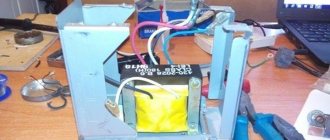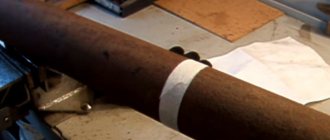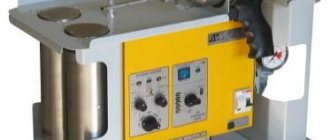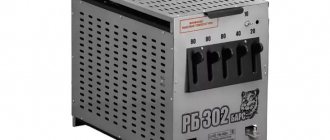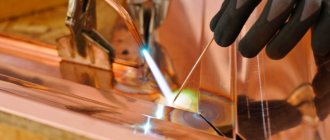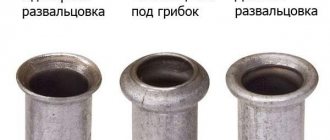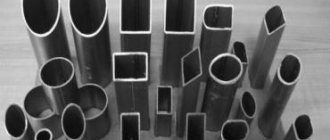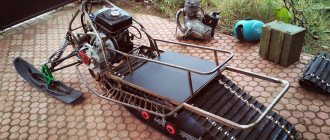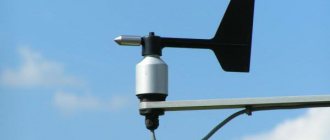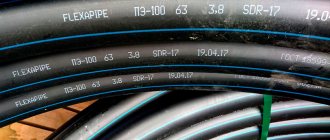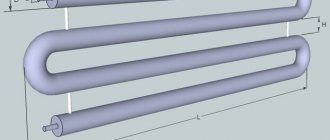Welding of copper pipes for pipeline construction is most often done by capillary soldering.
This method of permanently connecting copper pipes is quite easy to learn even for a non-professional welder, and at the same time provides an excellent result (in terms of strength and reliability of the connection).
This method of connecting pipes is based on the capillary effect - due to the phenomenon of adhesion, molten solder fills the weld, regardless of the position of the pipe. The use of capillary soldering allows you to solder even vertically installed copper pipes by supplying solder from below.
Equipment and materials for connecting pipes
Reliable connection of copper pipes requires compliance with certain conditions.
So, for effective soldering of copper, the temperature must exceed 425 degrees, but at the same time it should not exceed the melting point of the pipes being connected.
In addition, the distance between the surfaces to be joined must be minimal - this is a prerequisite for the occurrence of capillary forces, due to which the solder is distributed in the soldered joint.
All of the above applies to soldering copper pipes using hard solders. But if soft solder is used when connecting pipes, then the welding temperature should be below 425 degrees.
As you can see, the final result largely depends on the type and quality of solders. That is why we will try to figure out what solders are used when connecting copper pipes.
- Standard solder is most often used. It is suitable for soldering copper, brass and tinplate, and can also be used for tinning if necessary. However, this solder is not suitable for soldering pipes in drinking water pipelines.
- Soft solders for fittings are used to connect copper pipes to similar copper pipes or to pipes made of red bronze, but their main use is to connect copper pipes to brass fittings.
- Rothenberger ROLOT hard solder is the optimal solder for such a task as the installation of copper pipelines using the capillary-slot soldering technique.
This solder is used in cases where pipes are installed in pipelines of closed and open heating systems, in hot and cold water supply systems.
In addition to the quite obvious application, systems of copper pipes connected with Rothenberger ROLOT solder are widely used for gas supply (working with liquefied and natural gas), for completing refrigeration units, for air conditioning systems and oil pipelines.
For installation of copper pipelines using Rothenberger ROLOT series solders, fittings are not required.
These solders belong to the group of silver-containing copper-phosphorus solders and, due to their high mechanical characteristics (resistance to irreversible deformation), are widely used for welding pipes where pipes are subject to high mechanical and temperature loads.
Solder Rothenberger ROLOT
- Copper-phosphorus solders when soldering copper pipes are self-fluxing (unlike the situation with soldering brass or bronze - here flux is used to prevent oxidation).
Copper-phosphorus solders have a certain fragility (this is due to the phosphorus component), which is why they should not be used if the pipe material contains more than 10% nickel, and also for soldering aluminum bronze.
When soldering brass or bronze, flux is used to prevent the formation of an oxide coating on the base metals. When soldering copper and copper joints, copper-phosphorus solders are self-fluxing.
- Silver solders are similar in their performance characteristics to the previous ones, however, the reduced phosphorus content removes the restriction on their use when soldering non-ferrous metals.
Basic methods of welding copper to stainless steel
Stainless steel and copper are quite different in their compositions; the most common method of welding them is argon arc. It is also possible to use electric arc, and very rarely, ultrasonic welding.
Manual argon arc welding
This type of welding is performed with increased welding current, this is caused by the high thermal conductivity of copper. In some cases, it is permissible to use a steel backing. The essence of manual argon arc welding is the formation of a weld seam by melting the filler material.
To perform welding work, non-consumable tungsten electrodes are used. If another gas (nitrogen) is used instead of argon, then graphite electrodes must be used. Argon is 38% heavier than oxygen, which allows it to be successfully displaced from the welding area.
Argon arc technology makes it possible to achieve an iron content in the welding seam of up to 10%. And if you use cold welding, then its content will be more than 10%. To increase the final strength of the seam, it is additionally alloyed with zinc.
Required equipment:
- an inverter or other power source suitable for argon arc welding;
- tungsten electrodes;
- argon;
- gearbox;
- filler material;
- protective elements (welding helmet, gloves, etc.).
https://youtube.com/watch?v=6zZS5FoNzPs
Electric arc welding technology
This universal welding method can also be used for welding copper to stainless steel. Electric arc welding must be performed using a high current source with low voltage. The technology of the electric arc method simultaneously makes it possible to melt the metal of the electrode (or filler material) and the metal being joined, as a result of which a weld pool is formed.
An arc discharge occurs between the electrode and the metal. Melting occurs due to the local distribution of thermal energy of the arc, forming a weld pool and protective slag.
Necessary equipment:
- power supply;
- consumable or non-consumable electrodes;
- hammer, chisel;
- metal brush;
- filler material;
- protective clothing (mask, gloves).
Ultrasonic welding
This type of welding is used only in industrial areas. The essence of this method is the conversion of electrical vibrations into mechanical ones. Most often used for welding plastics, but it can also be used for non-ferrous metals.
Equipment:
- power supply;
- mounting bracket;
- vibration conversion system;
- drive to increase pressure force.
Tools for soldering copper pipes
Effective installation of copper pipes with your own hands is impossible without a certain set of tools.
When working with copper pipes, including their welding and installation, the following are used:
- Pipe cutter – a special tool for cutting pipes. The choice of pipe cutter model is determined by the diameter of the pipes you plan to work with, as well as specific conditions of use (for example, the need to cut pipes in hard-to-reach places). The larger the diameter of the pipe cutter, the higher its cost.
Pipe cutter - Chamfer - as the name of the tool suggests, it is used to remove chamfers and burrs from the edge of a cut copper pipe (to avoid the formation of scoring and burrs). Chamfer removers come in two modifications: in the form of a pencil or in a round case.
The latter modification is much more convenient to use, but the maximum pipe diameter for such bevel removers is 36 mm.
- A pipe expander is a special device that is used to expand the ends of a copper pipe during installation without the use of expensive fittings. The choice of expander also depends on the maximum diameter of the pipes used.
Note! In order for you to use a pipe expander effectively, the pipes must be either sufficiently soft or pre-annealed.
Pipe expander
- To prepare pipe surfaces for joining, either special sponges (“ROFLYZE”) or pipe cleaners and pipe cleaning brushes are used..
- Gas-burners . Different types of pipe connections and solder used require the use of different types of torches.
There are burners operating from stationary, rechargeable, reusable cylinders, as well as more compact burners using disposable gas cylinders. The burners use either propane or an acetylene-oxygen mixture as a fuel gas.
Copper pipe connection technology
So, the solder has been selected, all the necessary tools have been selected. It's time to move on directly to soldering the pipes.
Let's try to figure out what technology is used to connect and, if necessary, repair copper pipes?
- In order for the weld to be as strong and uniform as possible, it is necessary to prepare the surfaces. The main factor in such preparation is their cleaning. To clean the surface of a copper pipe before welding, use a ROFLAYZ sponge or a special brush.
Also, the surfaces to be welded must be protected from the possible entry of dust, dirt or grease into the weld - they will prevent the penetration of solder into the joint.
Note! It is strictly prohibited to use substances or tools containing abrasive particles to clean copper pipes before soldering!
- If we are going to install copper pipes in a cold or hot water supply system, as well as in a heating system with a maximum coolant temperature of no higher than 110 degrees, then we can do without the use of fittings to connect the pipes to each other.
To do this, expand the end of one of the connected pipes using a pipe expander to a diameter sufficient to fit into the hole of the second pipe, creating a space sufficient to fill it with solder.
- After the pipe is expanded, we insert another pipe into it (the depth of the entrance should be no less than the diameter of the pipe itself). The gap between the inner and outer pipes should be 0.025-0.125 mm.
Warming up the connection - We heat the connected pipes evenly along the entire length of the connection using a gas burner. The heat from the burner should be distributed evenly over the entire circumference of the connected pipes.
In this case, the solder does not need to be heated, and in no case should the connection itself be heated until signs of metal melting appear - this will negatively affect the service life and reliability of the weld in the future.
- Pipes for connection are considered to be heated to a sufficient temperature if the solder rod attached to them begins to melt upon contact with the pipe wall. To improve the result of connecting pipes, before starting soldering, we heat the solder rod in the flame of the burner, without, however, allowing it to melt.
The process of filling a seam with solder - If the metal surface is sufficiently cleaned, then the solder applied to the joint, under the influence of high temperature in the burner flame and capillary forces, begins to penetrate into the gap between the surfaces of the pipes. Since the molten solder moves towards the heat source, the pipes must be sufficiently heated.
- After all the connections have been soldered, the pipes are laid on a flat surface, avoiding sagging and deformation. The use of pipes is allowed no earlier than an hour after completion of the entire pipe welding technology.
What are the features of metal
Despite the high cost, copper products continue to be used.
This is explained by the following material characteristics:
- Safety for humans and the environment. The metal has antiseptic properties, which allows it to be used in the creation of water supply systems.
- Insensitive to ultraviolet radiation and aggressive substances.
- Resistant to changes in pressure and temperature.
- Plasticity, ensuring ease of installation.
- Unlimited product lifespan.
Rules for welding copper pipes
In order for welding and installation of copper pipes to be successful, it is necessary to adhere to the following rules during the work process.
So:
- For maximum welding efficiency, the gas torch flame should be slightly reduced. Such a flame creates maximum heating of the surfaces being joined, and at the same time cleans the joint.
- Before welding, all metal surfaces must be pre-cleaned (without compromising their integrity) and degreased. Welding of non-greased or contaminated surfaces is not permitted.
- Before heating, it is necessary to check the relative position of the parts, their size and the required clearances. If the gap between the parts is less than required by technology, we use a pipe expander with a nozzle of the appropriate diameter.
- When connecting copper pipes to copper pipes using capillary soldering, no flux is required when using copper-phosphorus solder (the solder is self-fluxing). When soldering copper pipes with pipes or fittings made of other metals (brass, bronze) or using other solder, apply a minimal amount of flux to the outside of the joint.
Excess flux must be removed after completion of pipe welding and before installing pipes during pipeline installation.
Connection via fitting
- When soldering, parts are heated evenly to the required temperature. Heating the parts being connected to their melting temperature is not allowed. In case of overheating and deformation, the part is rejected.
- The heating cycle of soldered parts should be as short as possible. Reheating cooled parts is undesirable - this leads to a decrease in strength characteristics.
- When soldering pipes, apply solder directly to the seam between the pipes, checking that it is evenly distributed in the weld. To distribute the solder evenly, heat the seam using a gas torch.
What mistakes are often made
Despite the fact that the entire soldering process consists of simple steps, novice craftsmen can make the following mistakes:
- Formation of defects on the surfaces of welded pipes. Protrusions may appear when cutting elements. They reduce the strength of the seam, contributing to the occurrence of leaks.
- Contamination of the connecting areas. After slicing, you should not skip the degreasing procedure.
- Wrong choice of technological gap width. For pipe cross-sections of 60-108 mm, the distance should be 0.7-5 mm.
- Insufficient heating of the metal. In this case, the filler material cannot firmly adhere to the base. The seam quickly collapses even with minimal loads.
- Uneven distribution of flux. Traces of oxide remain on the surfaces, reducing the strength of the seam.
- Overheating of the treated area. Promotes the evaporation of soldering acid and the appearance of scale.
- Displacement of parts when the connection is not cooled. Before checking the quality of work, make sure that the pipe is cooled. Otherwise, the seam will be deformed.
- Failure to comply with safety regulations. Failure to use skin, respiratory and eye protection may result in injury.
A novice master is recommended to carry out work under the guidance of a professional.
Safety precautions when welding copper pipes
When performing work on welding copper pipes, as well as when welding pipes using electric welding, it is necessary to strictly follow all safety regulations.
All work associated with the release of toxic gases and smoke (soldering using solders containing cadmium, soldering with fluxes containing fluoride compounds) must be performed in rooms that provide the proper level of ventilation.
In addition, precautions must be taken when working with gas heating pads - both those equipped with disposable cylinders and standard acetylene-oxygen ones.
You should also not forget about the use of protective clothing and personal protective equipment - a respirator, goggles and gloves.
